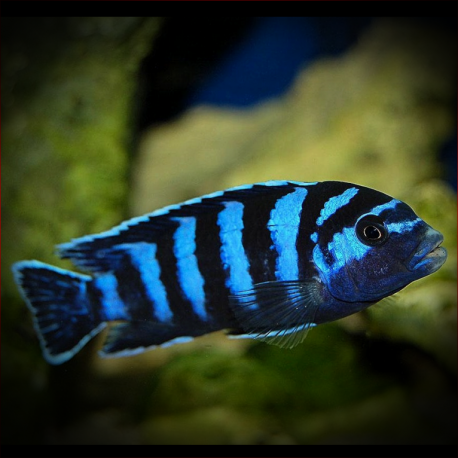More info
Datasheet
| Minimum Tank Size | 225 litres / 59.44 US gallons |
| Maximum Size | 7.6cm / 2.99inches |
| Temperament | Semi-aggressive |
| Care Description | Easy |
| Temperature | 24.4°C / 75.92°F - 27.8°C / 82.04°F |
| Carbonate Hardness | 10-15 |
| pH | 7.8-8.6 |
General Description
The Demasoni Cichlid, scientifically known as Pseudotropheus demasoni, is a striking fish species originating from Pombo Rocks, a rocky point in Lake Malawi, Tanzania, Africa. Possessing a stunning appearance, the male displays dark blue or black vertical stripes with alternating lighter stripes ranging from light blue to white, with distinctive spots on the anal fin. In contrast, the female lacks the vibrant colors and the anal fin spots.
Aquarium Setup
To house Demasoni Cichlids adequately, a spacious aquarium with numerous caves and hiding spots is essential for their well-being. It is recommended to use an aragonite-based substrate to support the high pH and alkalinity requirements of these fish. (See table for specific water conditions and tank size specifications)
Behaviour
These cichlids exhibit a semi-aggressive temperament, particularly during breeding and territorial instances. It is advisable to keep males with a minimum of three females to reduce aggression among themselves.
Feeding and Diet
Being herbivores, Demasoni Cichlids thrive on a diet rich in vegetables. Their feeding regimen can consist of flake food, dried seaweed, and algae to ensure their nutritional needs are met.
Reproduction & Dimorphism
During spawning, the female Demasoni Cichlid will lay eggs on a flat rock, then take the unfertilized eggs into her mouth for fertilization by the male. After an incubation period of approximately three weeks, the fry are released. Newly hatched brine shrimp, daphnia, or crushed flake food can be provided as initial food for the fry.
Habitat and Distribution
In their natural habitat of Lake Malawi's Pombo Rocks, Demasoni Cichlids prefer rocky areas with crevices for shelter. These cichlids are predominantly found in Tanzania, Africa, thriving in waters with specific temperature, pH, and alkalinity levels as indicated in the table.

